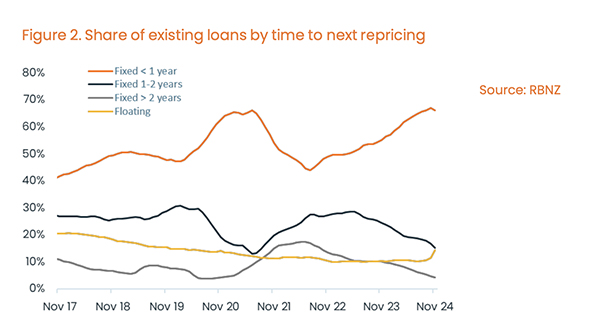
In recent months, falls in mortgage rates have understandably meant there’s been a strong focus on the ‘short end’ of the curve, with borrowers mostly choosing floating rates or 6-12 month fixes. However, the timing of a possible shift to longer-term fixed rates is shaping up as a key theme in the mortgage market this year.
The increase in mortgage lending activity has been underway for more than a year, accelerating in recent months. Over September to November, the increase in activity from the same months a year earlier averaged $1.3bn, compared to a rise of $0.8bn in the prior six months.
By loan type, house purchasing and bank switches have been the main contributors to growth, with loan top-ups more subdued. Naturally, it stands to reason that top-ups would be less common in an environment where house prices have fallen and borrowers’ paper equity is lower (or their effective loan to value ratio/LVR is higher) than it might otherwise have been.
However, there are a number of other interesting aspects to these figures:
- Average new (note: not existing) loan sizes are significant – around $549,000 for investors in November and $564,000 for first home buyers.
- However, there are few material signs that borrowers are reacting to budgetary pressures by going interest-only (I/O) – for example, only about 15% of new owner-occupier loans in November were I/O, a figure that’s been pretty stable for the past two years or so.
- Indeed, ‘peak fear’ from the banks about the possible risks of loan defaults also seems to have faded – collective provisions for potential bad housing debts have dropped from $977m in August to $870m now (albeit still much higher than $683m two years ago).
- Nevertheless, the appetite and/or availability for high LVR loans remains muted – for example, less than 12% of owner-occupier lending in November was done at <20% deposit, well under the 20% cap.
- First home buyers still account for much of that activity – they have consistently taken 75-80% of all high LVR (or low deposit) owner occupier lending for some time now, with around two in every five FHB loans being done at <20% deposit. This is shown in Figure 1.

Which brings us to the key question facing borrowers: to fix or not to fix?
On the latest data, only 10% of new loans were fixed for longer than 12 months, whereas only a year ago that figure was right up at 51%. On the flipside, the share of new loans on floating rates has risen from around 17% a year ago to 28% now.
This can all be seen in the stock measure of loans too (i.e. covering existing mortgages), with the share of debt on floating rates recently having lifted fairly sharply to 14%, the highest level since late 2020 – see Figure 2.
This focus on shorter terms makes sense as mortgage rates fall and borrowers try to ride that wave down as quickly as they can, rather than fixing for longer and having to pay ‘too much’ for a period of time until they can reprice again.
But this also hints at what could perhaps be the most intriguing aspect of the mortgage market in the year ahead: At which point do borrowers again deem there to be good value in the long-term rates and potentially start shifting to those loans?
The answer to that will be a decision for each borrower to make, but there is certainly a sense that most of the Reserve Bank’s eventual full monetary policy easing (and other global factors) has already been factored in to some current mortgage rates – or in other words, those longer-term rates might not fall much further.
Overall, then, we’d anticipate mortgage lending activity to continue to expand in 2025, going hand in hand with a further pick-up in property sales volumes (which we expect to rise from around 80,000 last year to 90,000 or so this year). Where mortgage rates head and how borrowers react to that will also be a key theme to keep an eye on, alongside the DTI caps – they don’t seem likely to suddenly lock out vast swathes of borrowers in 2025, but it wouldn’t be a surprise to see DTIs at least become a much more common part of the general discussion around lending quite soon.





Comments
No comments yet.
Sign In to add your comment